AI Pulse Weekly: The latest AI trends
Introduction
Artificial Intelligence is advancing rapidly. It is now filling data gaps, detecting cyber threats before they happen, and automating complex tasks with minimal human input. This week’s AI Pulse Weekly explores the latest AI trends shaping the future of AI.
📌 Cover Story: AI can now identify missing links in data, helping researchers predict trends, discover insights, and solve complex problems.
🔐 Feature Story: AI-driven cybersecurity is the new frontline against cyber threats, detecting attacks before they cause harm.
⚛️ Tech Spotlight: Quantum AI is making AI models faster and more efficient, solving problems that were previously impossible.
🤖 Industry Trends: Microsoft’s Large Action Models (LAMs) are changing how AI handles tasks, creating self-learning systems that require minimal intervention.
🔗 Newsletter Special: AI and Neurotechnology – Explore how AI is merging with the human brain, paving the way for mind-machine integration. From brain-computer interfaces to neural enhancements, discover the future where technology and cognition unite. 🧠⚡
Read and Download the January 2025 Edition Now for Free Now to Explore the latest AI trends
To read the January 2025 edition of AI Pulse Weekly, flip through our interactive PDF below. Whether you’re on your desktop or mobile device, this magazine lets you explore articles, visuals, and expert insights on the latest AI trends and ChatGPT innovations.
📥 Want to learn more? Download the full PDF or read online!
AI Pulse Weekly Magazine
Download the January 2025 Edition for Offline Reading
Prefer reading offline? Download the AI Pulse Weekly January 2025 Edition PDF to enjoy anytime, anywhere.
Download the PDFArticles in This Edition
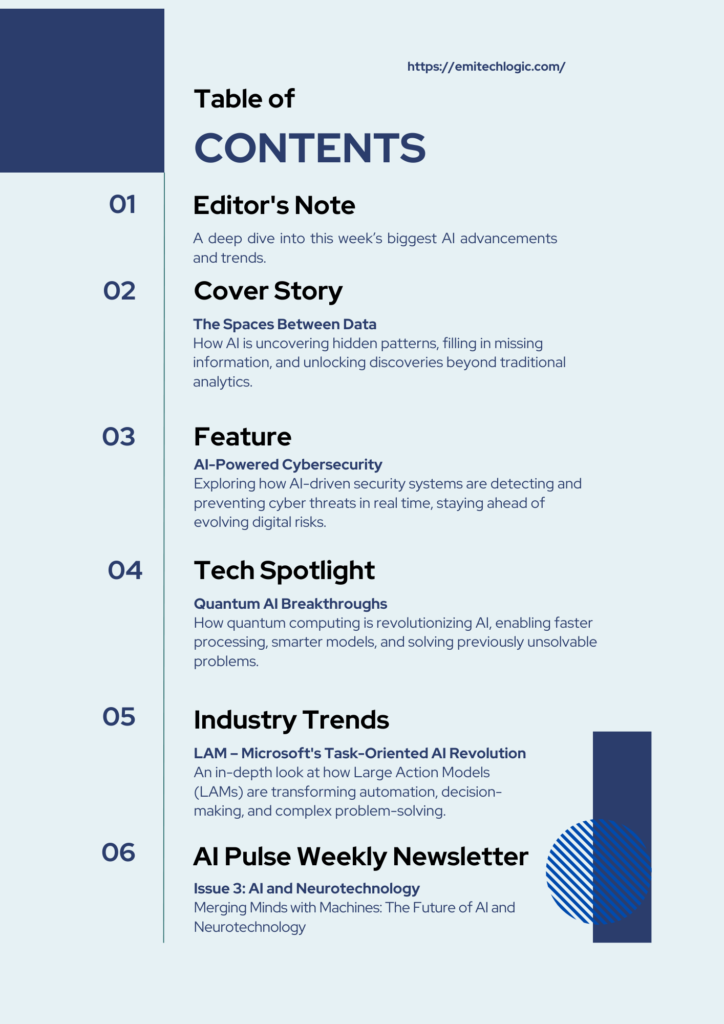
📌 Cover Story: The Spaces Between Data – How AI Is Unlocking the Unknown with the Latest AI Trends
AI is now capable of analyzing incomplete datasets. It can detect hidden trends, predict missing values, and generate insights where traditional models fail.
🔬 Scientific Research
Scientists use AI to predict undiscovered molecules in drug development. This helps pharmaceutical companies save time and money by reducing trial-and-error experiments.
🏦 Finance and Market Prediction
AI models analyze market trends and detect financial anomalies. This helps investors and banks identify risks and opportunities before they become obvious.
👩⚕️ Healthcare and Diagnostics
AI-powered models can predict diseases even when medical records are incomplete. For example, early detection AI can spot risks for cancer, diabetes, and heart disease before symptoms appear.
🛰️ Space Exploration and Climate Science
AI is helping astronomers identify exoplanets, black holes, and cosmic phenomena. Climate researchers use AI to predict temperature shifts and natural disasters, even with fragmented historical data.
💡 Key Insight: AI’s ability to fill gaps in data is revolutionizing research, finance, and medicine.
AI-Powered Cybersecurity: The New Frontline Against Cyber Threats and the Latest AI Trends
Cyberattacks are becoming more advanced every day. Hackers are now using Artificial Intelligence (AI) to break through security defenses, making traditional security measures less effective. But the good news is that AI is also being used to strengthen cybersecurity. AI-powered security systems can detect threats instantly, learn from new attack patterns, and respond faster than humans.
🔥 How AI is Changing Cybersecurity
AI is transforming the way we protect our data and systems. Here’s how:
✅ Instant Threat Detection
Traditional security methods rely on rules and signatures to detect threats. This means they can only stop known attacks. But AI can identify suspicious behavior even if it has never seen that type of attack before. AI-powered systems analyze millions of data points in real time, spotting unusual activity and preventing attacks before they cause damage.
✅ Self-Learning Security Models
Cyber threats are always evolving. New types of malware, phishing scams, and ransomware attacks appear every day. Traditional security software needs manual updates to recognize new threats. AI, on the other hand, learns and adapts on its own. It can detect patterns and predict new threats, staying one step ahead of hackers.
✅ Automated Response Systems
AI doesn’t just detect cyberattacks—it also responds automatically. When an attack happens, AI can block malicious traffic, isolate infected systems, and even repair damage before humans can react. This minimizes downtime and prevents hackers from causing serious harm.
🔍 AI vs. AI: The Cybersecurity Arms Race
Both cybercriminals and security experts are using AI, creating a high-stakes battle between good and bad AI. Here’s what each side is doing:
🛑 How Hackers Use AI
- AI-Generated Deepfake Scams: Hackers use AI to create fake videos and voices to trick people into revealing sensitive information.
- AI-Driven Malware: Some viruses can now change their code automatically to avoid detection by security systems.
- Intelligent Phishing Attacks: AI can generate realistic phishing emails that are harder to recognize as scams.
🔐 How Security Experts Use AI
- Automated Intrusion Detection: AI scans networks for suspicious activity and blocks potential attacks.
- AI-Powered Endpoint Protection: AI secures laptops, phones, and servers from malware and unauthorized access.
- Self-Healing Networks: When a cyberattack happens, AI can automatically fix vulnerabilities, preventing future attacks.
💡 Key Takeaway: AI-Driven Cybersecurity is Essential
Cyber threats are becoming smarter and more dangerous. Relying on traditional security is no longer enough. AI-powered cybersecurity provides faster detection, smarter protection, and automatic response—making it an essential tool in the fight against cybercrime.
Must Read
- The 1956 Dartmouth Workshop: How a Summer Workshop Defined Artificial Intelligence
- History of AI
- Interactive Introduction to AI: Machine Learning, Neural Networks & Supervised Learning for Beginners
- Python String Comparison Tutorial: Complete Guide
- How to Build a Python Port Scanner From Scratch
⚛️ Tech Spotlight in Latest AI Trends: Quantum AI Breakthroughs – How Quantum Computing Is Boosting AI Performance
Quantum computing is changing the way Artificial Intelligence (AI) works. Traditional computers process information one step at a time, but quantum computers can handle multiple calculations at once. This makes AI models faster and more powerful. With quantum computing, AI can solve complex problems that were previously impossible or would have taken years to compute.
🚀 Key Quantum AI Advancements
⚡ Faster AI Training
Training AI models takes a lot of time and computing power. For example, training a large AI model on a traditional computer can take months. With quantum computing, this training time can be cut down to hours. Quantum AI can process huge amounts of data much faster, helping researchers build smarter AI systems more quickly.
🔬 Medical Breakthroughs
In medicine, AI-powered quantum computers are helping scientists discover new drugs. Quantum computing can simulate molecular interactions to predict how different chemicals react. This helps in faster drug discovery, making treatments for diseases like cancer and Alzheimer’s available sooner. Instead of spending years testing drugs in labs, scientists can use quantum AI to find promising drug candidates much faster.
📈 Financial Predictions
Quantum AI is also transforming the finance industry. Investors and banks need to analyze huge amounts of financial data to make smart decisions. Traditional computers struggle with this, but quantum AI can process millions of market trends instantly. This helps financial experts predict stock prices, detect fraud, and make better investment choices in real time.
💡 Key Insight: Quantum AI is Breaking Limits
Quantum computing is pushing AI beyond its traditional limits. It is helping us make faster discoveries in science, improve healthcare, and revolutionize finance. As quantum technology continues to grow, we will see even more powerful AI systems that can solve some of the world’s biggest challenges.
Do you think Quantum AI will change the future?
🤖 Industry Latest AI Trends: LAM – Microsoft’s Task-Oriented AI Revolution
Microsoft’s Large Action Models (LAMs) are changing how AI automation works. Traditional automation follows predefined rules, meaning it can only handle specific tasks. But LAMs go beyond that—they understand entire workflows, making them smarter and more adaptable.
Unlike older AI systems that focus on single actions, LAMs can process multiple steps in a task, making decisions on their own. This means AI can handle complex operations with less human input, improving efficiency across different industries.
🔥 How LAMs Are Changing Industries
🏭 Manufacturing
Factories rely on automation to speed up production, but traditional AI still needs human supervision for complex tasks. With LAMs, AI-powered robots can understand entire workflows, making real-time adjustments without human intervention. This leads to faster production, fewer errors, and lower costs.
💬 Customer Service
Most AI chatbots today respond based on keywords, which can make conversations feel robotic. LAMs understand intent, meaning they grasp the full meaning behind customer messages. This allows for more natural conversations, better problem-solving, and higher customer satisfaction.
📊 Business Analytics
Businesses generate huge amounts of data, and sorting through reports takes time. LAMs can analyze entire reports and automatically extract key insights, helping decision-makers focus on what matters most. This speeds up data-driven decision-making and improves business efficiency.
💡 Key Insight: LAMs Enable Independent AI Problem-Solving
LAMs mark a major shift in AI—from simple task execution to independent problem-solving. Instead of just following instructions, AI can now analyze, adapt, and act on its own. This makes AI more useful in industries that require flexibility and intelligence.
What do you think about AI-driven automation?
🔗 Newsletter Special on Latest AI Trends: AI and Neurotechnology – The Future of Mind-Machine Integration
Artificial Intelligence (AI) and neurotechnology are coming together to create a new era of human-machine interaction. This technology is unlocking possibilities that once seemed like science fiction—allowing humans to control devices with their thoughts, enhance cognitive abilities, and even communicate directly with AI using brain signals.
🧠 How AI is Merging with the Human Brain
🔌 Brain-Computer Interfaces (BCIs)
Brain-computer interfaces (BCIs) use electrical signals from the brain to interact with machines. AI plays a key role in decoding these signals, allowing people to control prosthetic limbs, computers, and even robots using just their thoughts. Companies like Neuralink and OpenBCI are developing non-invasive and implantable BCIs, making this technology more accessible.
⚡ Neural Enhancements
AI-driven neurotechnology is also being used to boost human brain function. This includes:
- Memory enhancement: AI-powered implants could help individuals with memory loss regain cognitive function.
- Brain stimulation: AI-driven neural implants can improve focus and mental clarity, potentially helping people with conditions like ADHD or depression.
- Faster learning: By optimizing neural activity, AI may help people learn new skills and languages faster.
🏥 Medical Breakthroughs
AI-powered neurotechnology is transforming healthcare by helping patients with neurological disorders. Scientists are working on AI models that can:
- Restore movement for paralyzed individuals by reconnecting brain signals to muscles.
- Detect and treat epilepsy by predicting seizures before they happen.
- Help stroke patients recover faster by using AI-driven brain stimulation.
💡 The Future of AI and the Human Mind
- The integration of AI with the brain is still in its early stages, but it has huge potential to change how we interact with technology. As AI becomes more advanced, we could see a future where:
- People communicate telepathically using BCIs.
- AI enhances human intelligence to new levels.
- Mind-controlled devices become part of everyday life.
The future of AI and neurotechnology is coming faster than we expect. Are we ready for a world where technology and cognition fully unite?
Conclusion
From quantum breakthroughs to mind-machine integration, the world of AI continues to reshape how we think, work, and live. Whether it’s enabling faster decision-making through quantum AI, transforming automation with LAMs, or pushing the boundaries of human potential with neurotechnology, one thing is clear—AI is no longer just a tool; it’s becoming a core part of our future.
As we step into this new era, the collaboration between AI and humans promises a future filled with innovation and possibilities. But with such advancements come challenges, including ethical concerns, security risks, and the need for thoughtful regulation.
Stay tuned to AI Pulse Weekly for more insights into the technologies shaping tomorrow.
FAQs
1. What are Large Action Models (LAMs), and how do they improve AI automation?
LAMs are advanced AI models that understand entire workflows, allowing AI to handle complex tasks with minimal human intervention. They make automation smarter and more adaptable across industries like manufacturing, customer service, and business analytics.
2. How does quantum computing enhance AI performance?
This is a placeholder tab content. It is important to have the necessary information in the block, but at this stage, it is just a placeholder to help you visualise how the content is displayed. Feel free to edit this with your actual content.
3. What are Brain-Computer Interfaces (BCIs), and how do they work with AI?
BCIs allow direct communication between the brain and machines using AI to decode brain signals. They enable applications like mind-controlled devices, memory enhancement, and neural stimulation for medical and cognitive improvements.
4. How is AI being used in cybersecurity?
AI improves cybersecurity by detecting threats in real time, adapting to new cyberattacks, and automating security responses. It helps combat AI-driven cyber threats, like deepfake scams and intelligent phishing attacks.
5. What ethical concerns come with AI-driven neurotechnology?
Key concerns include privacy risks, data security, and potential misuse of brain data. As AI and neurotechnology advance, regulations will be needed to protect user rights and ensure ethical applications.
External Resources
Enabling Quantum Computing with AI – NVIDIA’s technical blog explores how AI supports various aspects of quantum computing, including processors, error correction, and algorithms. Discover more here.


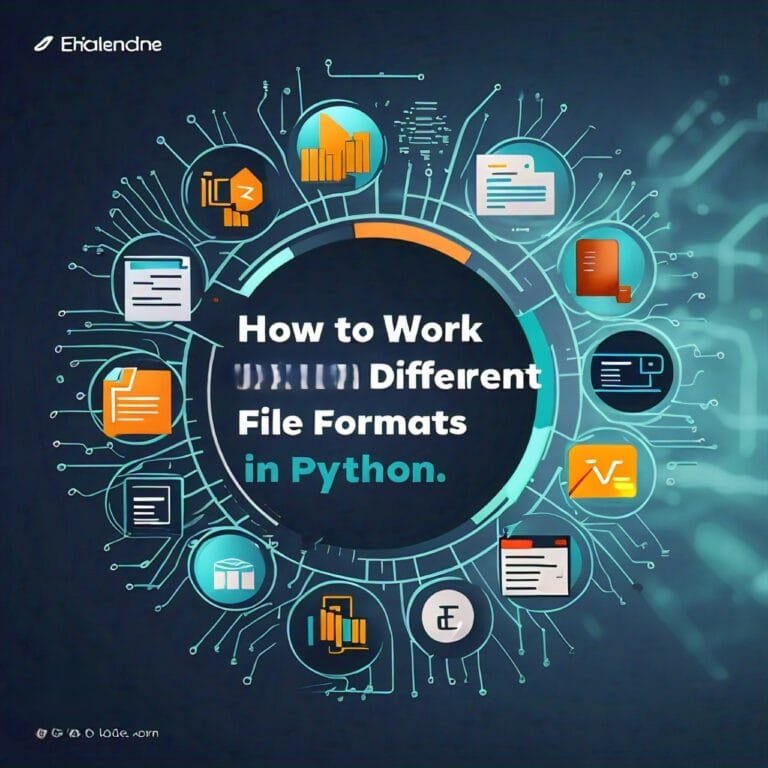
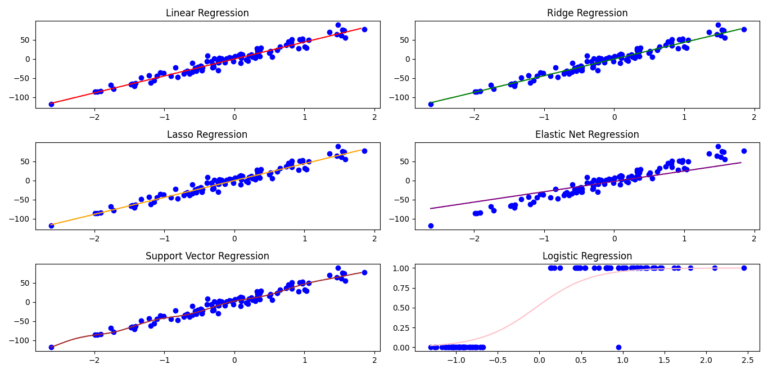

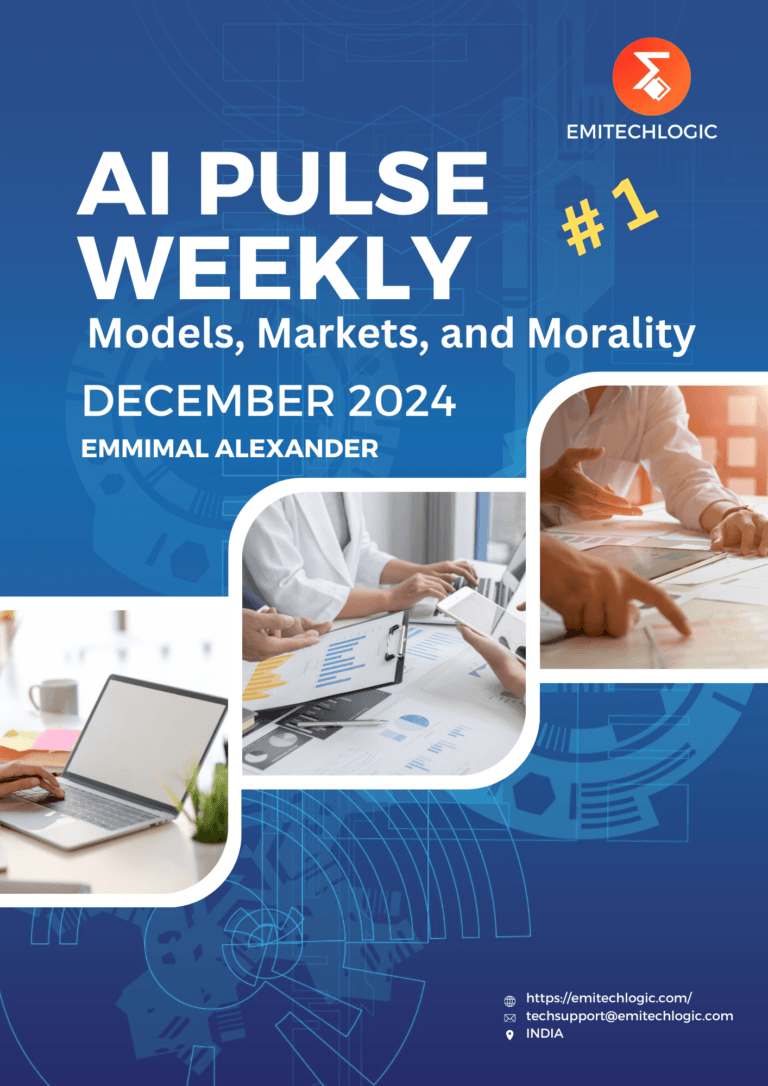
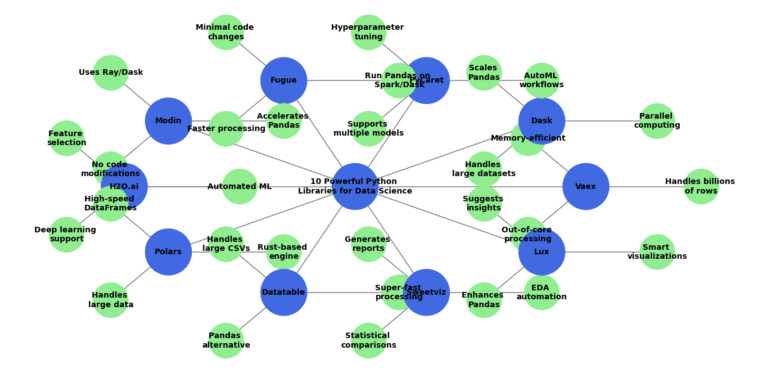
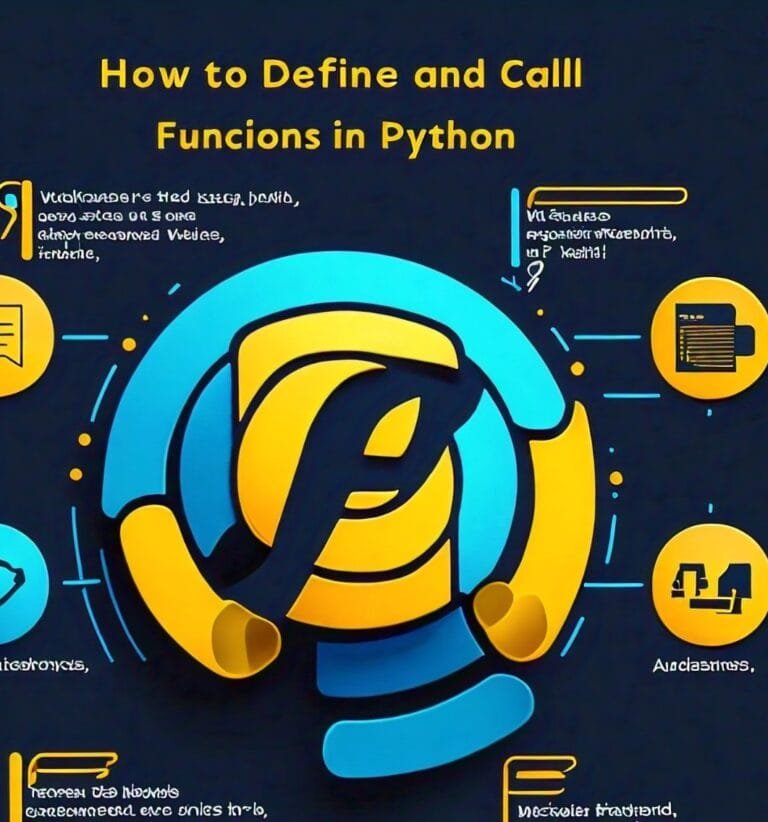
Leave a Reply